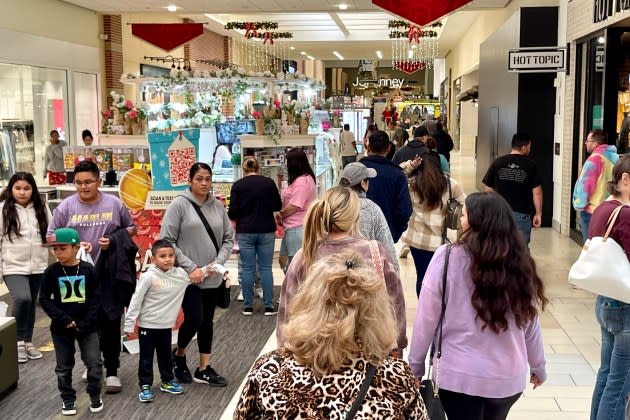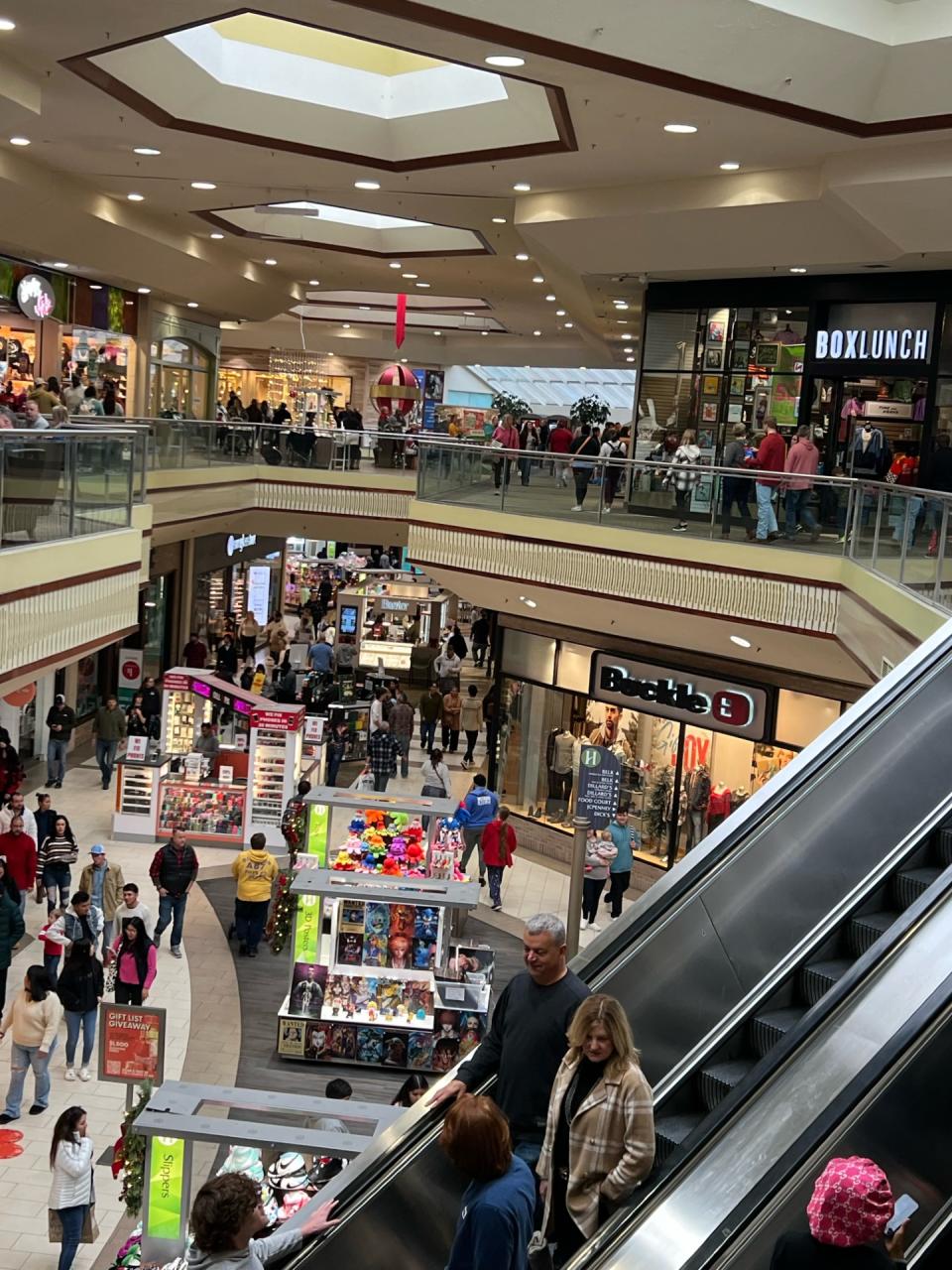Late Gift Shoppers Lift Retail From December Lull

Crowds descended on malls and downtown shopping districts last weekend, pulling retailers out of their early December lull and building anticipation for some serious last-minute gift shopping through the Super Saturday weekend ahead.
Rain and winds hit much of the East Coast over the weekend, impacting traveling, but barely impeding the shopping.
More from WWD
Fifth Avenue in midtown Manhattan on Sunday, which was closed to traffic from noon to 6 p.m. from 48th to 57th Streets, was filled with shoppers and tourists. Macy’s Herald Square and Bloomingdale’s 59th Street were teeming with visitors, and reports from industry experts on the turnout at malls were also positive.
“We definitely saw the traffic build over the weekend. It was stronger than the previous weekend,” said Stephen Lebovitz, chief executive officer of CBL Properties, the Chattanooga, Tenn.-based real estate investment trust with a total 94 malls, open-air, lifestyle and outlet centers.
Asked about Super Saturday and the week ahead, Lebovitz said, “It’s going to be busy. Most schools are out. That will help with traffic. Retailers are saving their strongest promotions for Super Saturday,” which this year is Dec. 23.
“Everybody in the mid-price range was up last week. Anthropologie was killing it,” said one senior executive from a major shopping center developer who characterized malls as busy over the weekend. “Luxury was not down as much,” the executive added, referring to the softening trend in luxury sales in recent months.
“King of Prussia outside Philadelphia was super crowded,” said Evan Gold, executive vice president of Planalytics, who visited the regional mall, one of the nation’s largest.
According to Lebovitz, last weekend’s selling trends were consistent with the Black Friday weekend, with shoppers gravitating toward cosmetics, casual jewelry, sporting goods and giftables such as stocking stuffers. “The more promotional the store, the better it did.”
Lebovitz also noted that stores are up against tough holiday comps from last year, but that department stores at CBL Properties are making their sales plans. Department stores this year have generally experienced revenue declines from a year ago.
Retailers are expected to experience mediocre holiday gains 2 to 4 percent over last year’s, with a strong windup to the season. Nearly 142 million consumers plan to shop on Super Saturday, according to a survey from the National Retail Federation and Prosper Insights & Analytics. That’s a significant increase from the last time Super Saturday fell on Dec. 23, when 126 million consumers were expected to shop on that day in 2017, according to the NRF.
Super Saturday could emerge as the biggest shopping day of the year, even bigger than Black Friday. “Retailers are saving some of their strongest promotions for Super Saturday. It’s going to be crazy,” said Lebovitz.

Early holiday promotions, some as early as October this year, pulled some sales out of traditionally big shopping days such as Black Friday and Cyber Monday, though retailers told WWD that Cyber Week, which runs from Thanksgiving to Cyber Monday, overall saw decent levels of purchasing. The early holiday campaigning, however, is not expected to take the wind out of Super Saturday.
Actually, this whole week should be very busy at brick-and-mortar stores for a number of reasons. Millions of Americans wait until a few days before Christmas to buy gifts hoping to get what they expect will be the biggest discounts of the season; the weather this week will be favorable to shopping on most days and through most of the country, and many schools are closed this week for the holidays.
Furthermore, crowds at stores will build in the final days before Christmas because online ordering slows as deadlines for getting deliveries before Christmas are reached. According to a report Monday from RetailMeNot, the website listing coupons, promo codes for discounts, and cash-back offers, “While standard shipping takes three to five business days, that does not include processing time — the time it takes a retailer to pull your item, box it up and send it. So don’t think that an item ordered exactly five days before Dec. 24 will arrive on time. Retailers need a little lead time (often a day or two, best-case scenario) to ready your order for shipping.”
“The warm temperatures and overall dry conditions this week, particularly on Super Saturday, will support foot traffic into malls, shopping centers and restaurants. But the West Coast may be an exception here, which begins the week warm and will cool down to below last year by end of week and also have rainfall in major markets and snowfall in higher elevations,” said Gold, of Planalytics.
Gold said that Los Angeles will be in the 60s and 70s this week, and will cool down by late week. “Rainfall will be the bigger story there, particularly mid-week, but clearing by late week/Super Saturday.”
Through much of the country, warmer conditions compared to last year will suppress the year-over-year demand for seasonal categories, Gold said. “Chicago will have temperatures in the 40s for much of this week, which is more than 20 degrees warmer than last year. New York City will begin the week warm, in the 60s, and cool down by the end of the week, although it will still have temperatures warmer than last year…From a comp perspective, the same retail week last year was the coldest since 2000 across the U.S.”
Asked about last weekend’s storms, Gold said, “The impact along the Southeast, Mid-Atlantic, and Northeast regions over the past few days and into today (Monday) have not been significant from a retail perspective. Because this was rain versus snow, and because the heaviest rain in the major Northeast markets were late in the weekend, the impact on store traffic was minimal. Consumers were able to get to malls and shopping destinations.”
One CEO of an international fashion brand on Monday told WWD, “The holiday period around Thanksgiving was very strong. December was off to a weaker start. We are on budget, but more generally business at retailers was absolutely not robust… Now everyone is approaching 2024 very conservatively. The non-luxury customer has been impacted by inflation and making very selective choices.” While some prices have come down, such as on gas and eggs, customers aren’t feeling it. “There is still an inflation hangover that is preventing customers from buying more robustly. It did seem that much of retailing was in a real lull. People are predicting sales to be up. How it’s all going to wrap up, I don’t know. Certainly, promotional strategies are aggressive. It’s a very promotional environment. Retailers I deal with are on promotions all the time.”
Data from RetailNext, which uses technology to track retail traffic at stores and shopping centers, indicates how deep the December retail lull was. U.S traffic trends for the second week of December were down 4 percent compared to 2022, with net sales down 4.7 percent. The conversion rate was down 0.7 percent compared to last year, while units per transactions were down 1 percent and the average transaction value was up 1.7 percent versus the same period of 2022.
RetailNext also said that traffic in the second week of December was down 0.9 percent at health and beauty stores, followed by footwear stores at negative 3.6 percent, and apparel stores at negative 4.1 percent. Traffic at jewelry stores was negative 4.3 percent and home stores were down 6.7 percent compared to last year’s December week two.
All regions were down during the second week of December, with the Midwest down 3 percent; the West down 4.2 percent; the South dipping 4.3 percent, and the Northeast declining 4.6 percent.
Traffic in mall stores was off 4.2 percent. At non-mall stores, traffic was off 3.8 percent for December week two. Traffic in outdoor mall stores was down 5 percent compared to negative 3.5 percent for indoor mall stores.
Best of WWD

